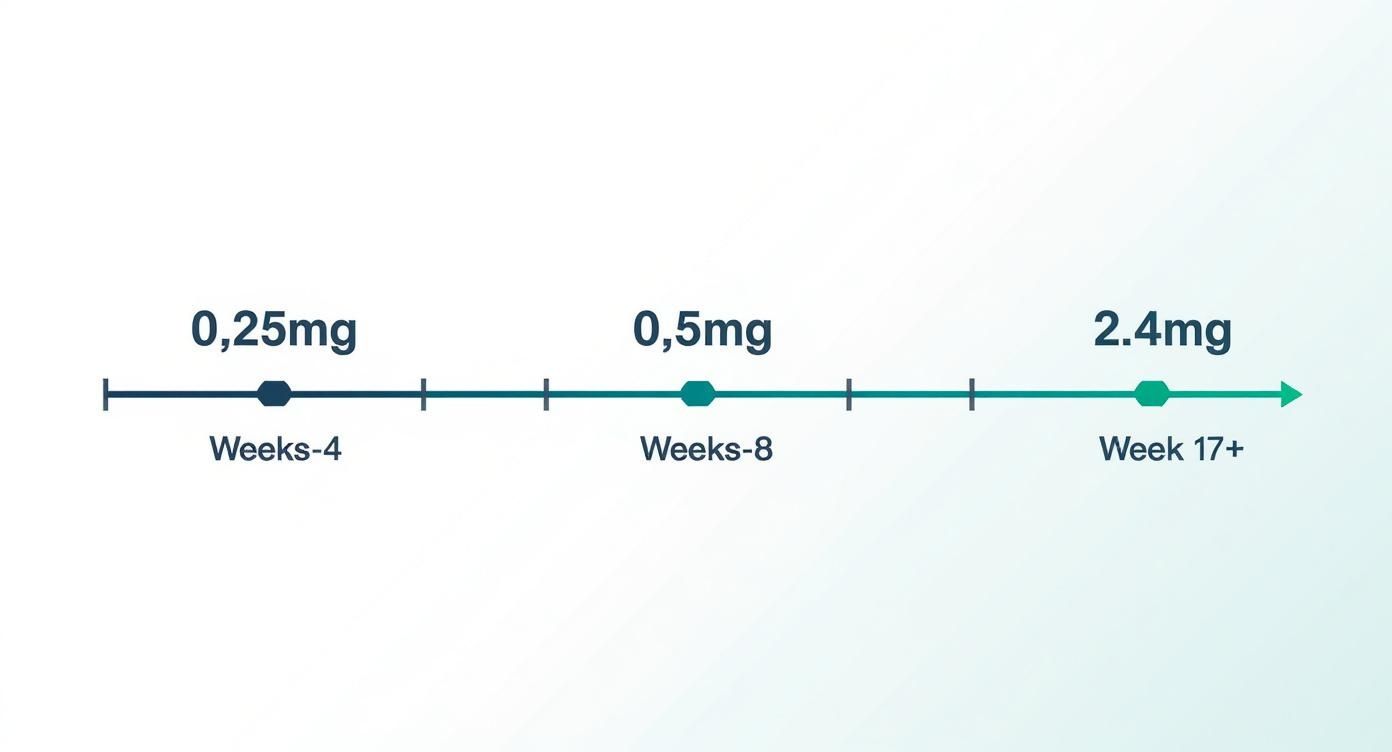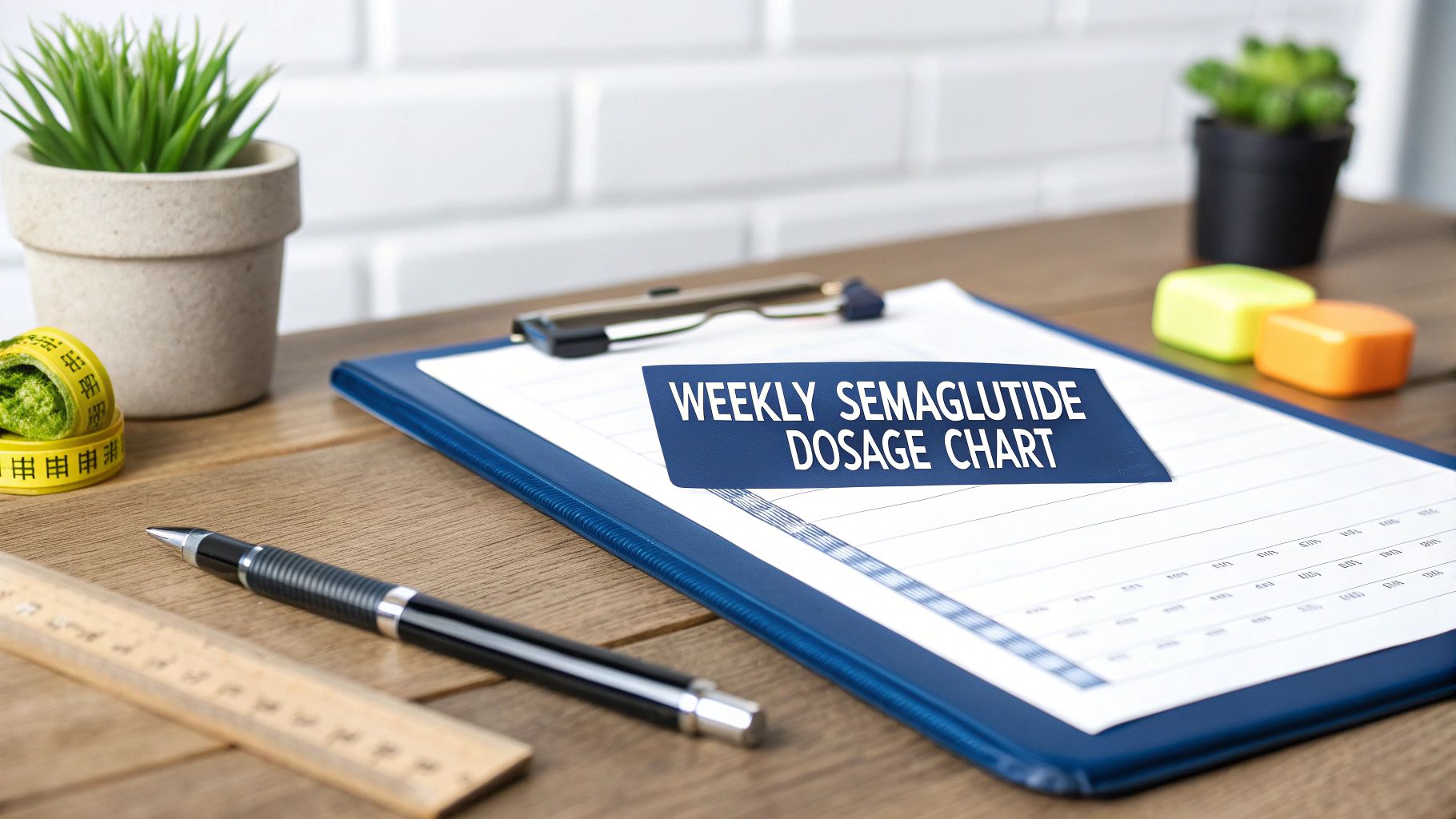
Understanding the Semaglutide Dosage Chart for Weight Loss
Share
When you begin using semaglutide for weight management, the dosing schedule isn’t a one-size-fits-all sprint. Instead, it’s a carefully structured journey where the dose is increased gradually over several months. This "start low, go slow" method is key to helping your body adjust to the medication and minimizing potential side effects.
Think of it as an acclimation period for your body. By increasing the dose slowly, you give your system time to adapt, making the entire process more comfortable and setting you up for long-term success.
The Standard Semaglutide Dosing Schedule
The path with GLP-1 medications like semaglutide is a well-mapped process. The standard approach for weight management starts with a very small dose, which is then carefully increased over time.
This introductory phase usually lasts for the first four weeks. From there, the dose is stepped up about every four weeks until you reach the full maintenance dose. This thoughtful progression is essential for achieving the best results with the fewest side effects, supporting your long-term health and wellness.
The Titration Timeline Explained
The most common dosing schedule involves increasing your weekly injection in specific steps. The goal is to reach the target maintenance dose of 2.4 mg by about the 17th week of treatment. This allows for a gentle and effective transition.
Here’s a look at what a typical month-by-month titration schedule looks like.
Table: Standard Semaglutide Titration Schedule
This table outlines the standard month-by-month dosage increase for semaglutide in weight management programs, designed for safety and effectiveness.
| Month | Weeks of Treatment | Weekly Semaglutide Dose (mg) |
|---|---|---|
| 1 | Weeks 1–4 | 0.25 mg |
| 2 | Weeks 5–8 | 0.5 mg |
| 3 | Weeks 9–12 | 1.0 mg |
| 4 | Weeks 13–16 | 1.7 mg |
| 5+ | Week 17 and onward | 2.4 mg (Maintenance Dose) |
As you can see, each increase is followed by a four-week period at that new dose level. This gives your body plenty of time to adapt before moving to the next step. Your healthcare provider will monitor your progress and how you're feeling at each stage.
This visual timeline breaks down the titration process, showing how you move from the initial starting dose to the final maintenance level.

As the infographic shows, each dosage step is intentionally spaced out. This deliberate pacing is the cornerstone of a successful and comfortable treatment plan. You can find more details about this structured approach on specialized health resources.
Why This Schedule Matters for Your Journey
Following this structured semaglutide dosage chart is about more than just remembering a weekly injection; it’s about working with your body, not against it. Giving your system the time it needs to adjust is what makes the treatment tolerable and helps you stay on track for your health goals.
This patient approach sets the foundation for lasting success. It supports your body’s physical adaptation and also gives you time to build the healthy, sustainable habits that will support your longevity.
At Blue Haven Rx, we believe in a supportive and personalized journey. To see if a medically supervised program is the right next step for you, start by taking our quick online quiz.
Why Gradual Titration Is Essential for Success

It's a common question we hear: "Why can't I just start on the highest, most effective dose of semaglutide right away?" The answer is found in a careful, methodical process called titration, which is the cornerstone of a successful weight management plan. The entire strategy is built on a simple, proven principle: "start low, go slow."
This gradual increase is designed to give your body the time it needs to acclimate. By introducing semaglutide in small, controlled steps, you dramatically reduce the chances of experiencing intense side effects. This is especially true for common gastrointestinal issues, like nausea, which can be a real roadblock if they hit too hard, too soon.
Allowing Your Body to Adapt
Think of titration as a gentle introduction, not a sudden shock to your system. Each four-week period at a specific dose is like a training phase, giving your body a chance to get used to the medication before you move up. This deliberate pacing is all about your comfort and ensuring you can stick with the treatment long-term.
Rushing the process by skipping doses or jumping to a higher strength can often backfire. The discomfort can be so significant that it causes people to abandon their treatment entirely. Patience during titration is key for achieving sustainable, healthy results.
This approach does more than just help your body adjust physically. It also creates the space you need to build healthy habits that support your journey toward a longer, healthier life. As the medication starts to work and your body gets comfortable, you can focus on those crucial lifestyle changes. To see how this fits into the bigger picture, you can learn more about GLP-1s for weight loss in our detailed guide.
At Blue Haven Rx, we believe in working with your body. This guided, supportive process is central to how we help you reach your goals, making the path as smooth and effective as possible.
Navigating Each Step of the Dosing Schedule
Understanding your semaglutide dosage chart is about more than just memorizing numbers—it’s about knowing what’s happening in your body at each step. Every stage of the titration schedule is there for a reason, designed to make your experience as smooth as possible while setting you up for lasting success.
The entire process is carefully structured to balance getting results and feeling your best. We start low at 0.25 mg weekly for the first four weeks specifically to help your body get used to the medication and minimize common side effects. From there, you'll typically increase the dose every four weeks, moving through 0.5 mg, 1.0 mg, and 1.7 mg, on your way to the final maintenance dose. For a deeper dive into this gradual approach, you can find more great insights in this guide on TryEden.com.
This methodical increase is the key to a more comfortable and effective health journey.
Months 1 and 2: The Foundation Phase
Think of your first month as the "getting acquainted" phase. The starting dose is 0.25 mg per week. It’s important to know that this dose isn’t meant for major weight loss. Its real job is to gently introduce the medication to your system, building a solid foundation for the higher doses to come.
In the second month, your dose will likely increase to 0.5 mg weekly. This is often when people start to notice the first real effects on their appetite and how full they feel. Your body is still adapting, but now you’re also starting to build momentum toward your weight management goals.
Months 3 and 4: Building to Effective Levels
Month three usually brings a step up to 1.0 mg weekly. At this point, you're entering what are considered more effective, therapeutic levels of the medication. Many people find they have a more consistent sense of fullness and that nagging food cravings begin to fade, which naturally helps support healthier eating habits.
By the fourth month, you'll probably move to 1.7 mg weekly. This is a big step toward the final maintenance dose. Your body should be well-adjusted by now, and the medication's effect on appetite control is typically very clear, helping to power steady progress.
Key Takeaway: Those four-week periods at each new dose aren't random. They're intentional pauses that give your provider time to check in on how you're feeling and ensure you’re comfortable before moving up. This makes the whole process safer and more sustainable for healthy living.
Month 5 and Beyond: Reaching the Maintenance Dose
Around week 17, most people reach the full maintenance dose, which is typically 2.4 mg weekly. This is the target dose that has shown powerful and reliable support for long-term weight management in clinical studies.
Once you’re at this level, the focus shifts to consistency. Staying on the maintenance dose, combined with your ongoing lifestyle changes, is what helps you not only continue your progress but also sustain it for the long haul. This phase is all about locking in those new, healthy habits for good.
Every person's journey is different. To see if a medically supervised GLP-1 program like the one offered by Blue Haven Rx is a good fit, you can start with our simple quiz.
How to Manage Side Effects as Your Dose Increases

As you move up your semaglutide dosage chart, it’s not unusual to experience a few mild side effects. This is a normal part of the process as your body gets used to the medication. The good news is these feelings are almost always temporary and can be managed with a few practical tips.
Most of the time, the issues are gastrointestinal—things like nausea or a general feeling of fullness. A few simple, proactive tweaks to your daily routine can make a huge difference in how you feel and help you stick with your treatment plan.
Practical Tips for a Smoother Journey
Navigating this adjustment phase can be simple with a few consistent habits that help your body adapt to each new dose. These tips are easy to incorporate into your daily routine and support your overall well-being.
Here are some practical tips that can help you manage common side effects:
- Eat Smaller, More Frequent Meals: Instead of three large meals, try five or six smaller ones. This simple change can help prevent that "overly full" feeling that often triggers nausea.
- Stay Well-Hydrated: Sipping water throughout the day is crucial. Good hydration helps with digestion and can also combat feelings of fatigue.
- Choose Bland Foods: If your stomach feels a bit sensitive, stick to easy-to-digest foods like plain crackers, toast, or rice. It's best to avoid greasy, spicy, or overly sugary foods until any queasiness passes.
It’s also worth noting that other side effects can occur. Some people experience issues like GERD after taking GLP-1s like Ozempic and other semaglutides. Being aware of the possibilities is key to managing your health proactively.
Most Importantly: Keep an open line of communication with your healthcare provider. They are your best resource and can offer personalized advice or adjust your plan if needed.
Your comfort is the top priority. By using these strategies, you can take control of side effects and make sure your path toward your health goals is as smooth as possible. To see how a supportive program can guide you, start your journey with Blue Haven Rx today.
What to Do If You Miss a Weekly Dose

Life gets busy, and you might occasionally forget your weekly injection. If this happens, don't worry. The key is knowing how to get back on track safely so you can continue your semaglutide journey without a major interruption.
What you do next depends on when your next dose is due. Following a simple guideline can take the stress out of the situation. Remember, the goal is consistency for long-term health, not perfection.
A Simple Rule of Thumb
The general rule for a missed dose is straightforward and designed to keep the medication levels in your system as stable as possible. This is important for managing your appetite and ensuring the treatment remains effective.
Here’s a quick guide on what to do:
- If your next scheduled dose is MORE than 2 days (48 hours) away: Take the missed dose as soon as you remember. Then, simply resume your regular weekly schedule.
- If your next scheduled dose is LESS than 2 days (48 hours) away: In this case, it's best to skip the missed dose entirely. Just wait for your next regularly scheduled day and take your dose as planned.
Important: Never take two doses at once to "catch up." Doubling the dose can significantly increase the risk and intensity of side effects and is not a safe practice. The aim is to get back into your routine smoothly.
Keeping to your schedule is especially important when you're away from home. A little planning goes a long way.
When in doubt, the best course of action is always to contact your healthcare provider. They understand your specific health situation and can give you personalized advice to ensure you feel confident and supported.
To learn more about a medically supervised weight management program, take the Blue Haven Rx quiz to get started.
Why Your Dosing Plan Must Be Personalized
Think of the standard semaglutide dosage chart as a roadmap, not a rigid set of rules. It's an excellent starting point, but everyone's body is different. Your metabolism, your overall health, and how you react to the medication are unique to you. That's why a one-size-fits-all approach doesn't work for long-term weight management success.
This is exactly why working with a healthcare provider is so important. They use the standard chart as a guideline but will fine-tune it based on what's happening with your body. They monitor your progress and listen to how you feel every step of the way to ensure your plan supports your healthy living goals.
Factors That Influence Your Personal Dosing Schedule
Your provider might adjust your dosing plan for a number of reasons. The ultimate goal is to find the sweet spot: the most effective dose that you also tolerate comfortably. This makes the experience positive and, more importantly, sustainable for a healthier lifestyle.
Here are a few things that can influence your personalized schedule:
- Your Body's Response: Some people notice a big drop in appetite right away. Others might need to gradually work up to the full maintenance dose before they see the results they're looking for.
- Side Effect Tolerance: If you're dealing with persistent side effects, your provider won't just push you to the next level. They might keep you at a lower dose for longer or slow down the titration schedule to give your body more time to adjust.
- Your Overall Health Goals: Your plan will also be shaped by your specific weight loss targets and what you hope to achieve for your overall health and longevity.
This personalization is where the real value of a guided program lies. Having a medical expert who can adjust your plan based on your feedback is what makes the journey both safe and effective, giving you the best chance at reaching your goals.
This customized approach highlights why it's wise to partner with a professional who understands GLP-1 therapy. To get a better feel for how this all comes together, you can read our guide on how to get semaglutide through a supervised program.
Ultimately, a plan built just for you is the smartest strategy for achieving results that last.
Common Questions About Semaglutide Dosing
Even with a detailed dosing chart, it's normal to have questions as you begin your treatment. Getting clear answers can help you feel more confident and prepared for discussions with your healthcare provider.
Let's explore some of the most frequent questions we get about the semaglutide dosage chart and what you can expect.
Can I Speed Up My Dosing Schedule?
It's natural to want to speed things up when you're motivated to see results. However, rushing the titration schedule is not recommended. The "start low, go slow" method is designed to let your body get used to the medication gradually for your safety and comfort.
Jumping to a higher dose too quickly can backfire by making side effects, especially nausea, more intense. This can make the treatment unpleasant and might even cause you to stop. The most effective and comfortable path is to trust the process and stick to the schedule your doctor provides.
What if the Side Effects Are Too Intense?
If you've recently increased your dose and the side effects feel overwhelming, the first step is to contact your provider. This is a common situation, and they have several ways to help you manage it and feel better.
Your doctor might suggest one of a few strategies:
- Holding at your current dose for a couple of extra weeks to give your system more time to adjust.
- Moving back down to the previous dose that you tolerated well.
- Trying new strategies to manage the specific side effects you're experiencing.
The ultimate goal is to find the highest effective dose that you can also tolerate long-term. Honest communication with your provider is key to striking that perfect balance for your body and your health journey.
How Long Will I Be on the Maintenance Dose?
When used for chronic weight management, semaglutide is generally considered a long-term therapy, not a temporary fix. Once you and your provider find your maintenance dose—the one that effectively manages your appetite—the idea is to stay on it to maintain your results and support your healthy lifestyle.
Continuing the maintenance dose helps sustain the positive changes in appetite and supports the new, healthy habits you've worked hard to build. How long you stay on it is a personal decision made with your doctor, based on your progress and overall health goals. Think of it as an ongoing tool in your commitment to a healthier, longer life.
At Blue Haven Rx, we're committed to a supportive, personalized approach to weight management. Our medical team is here to guide you every step of the way, ensuring your treatment plan is tailored specifically for you.
Ready to learn more about how a medically supervised program can help you reach your goals? Take our quiz to start your journey today.